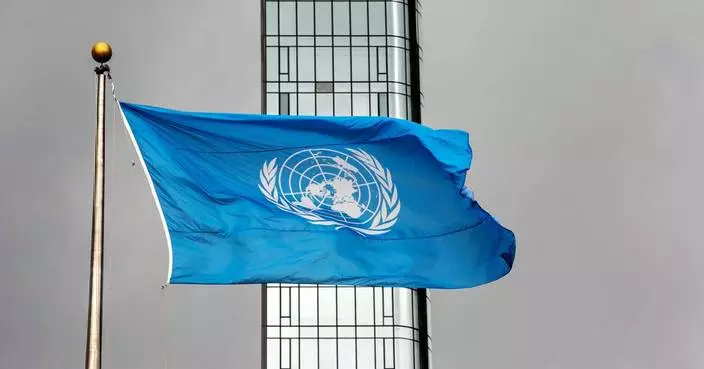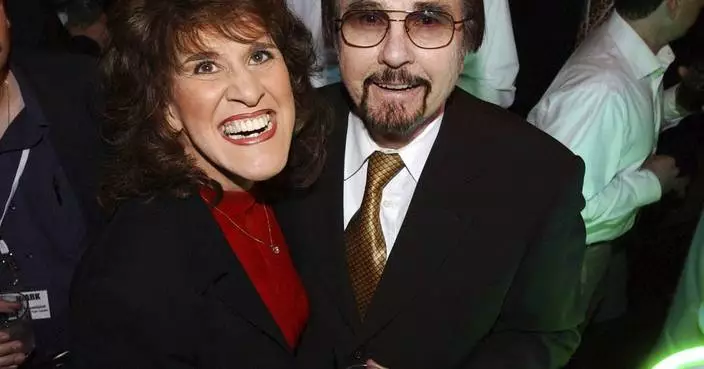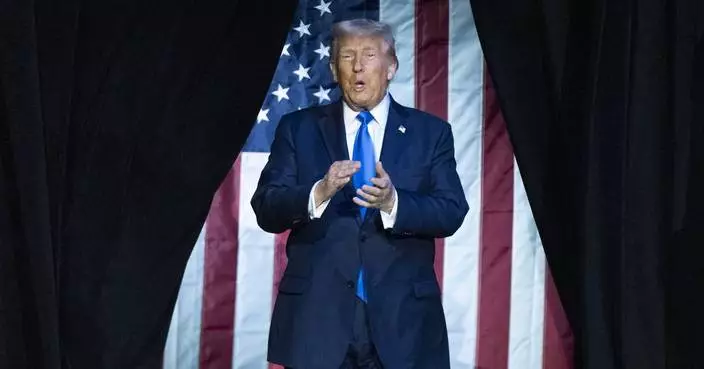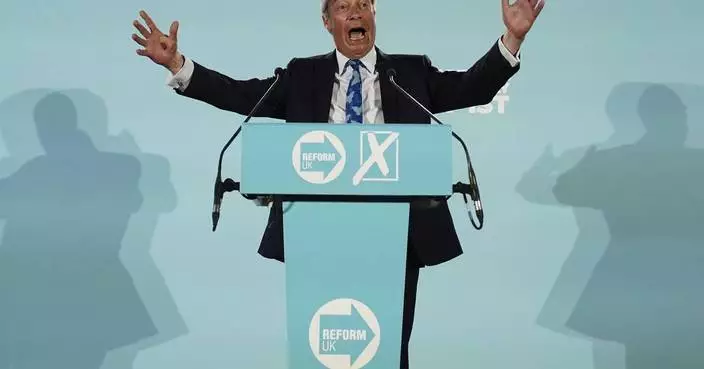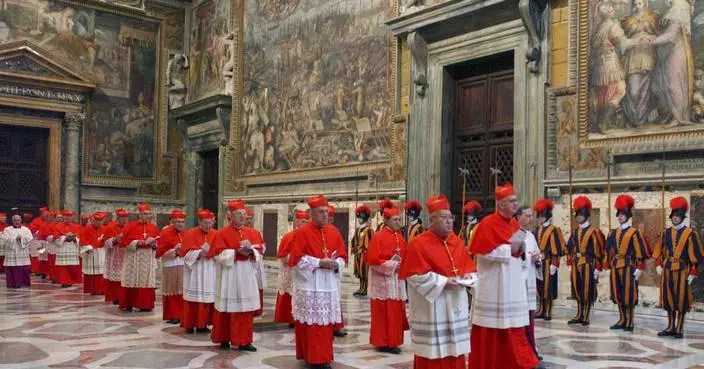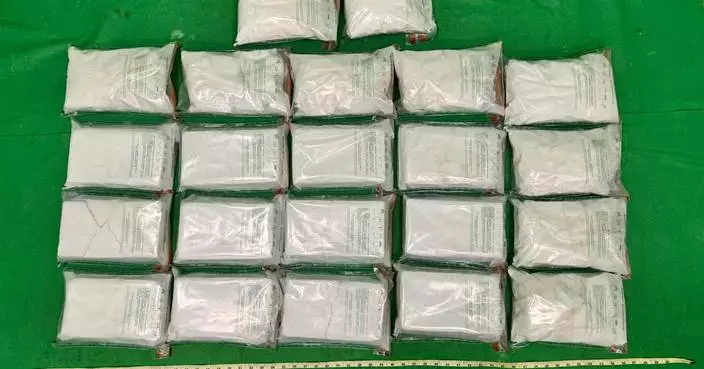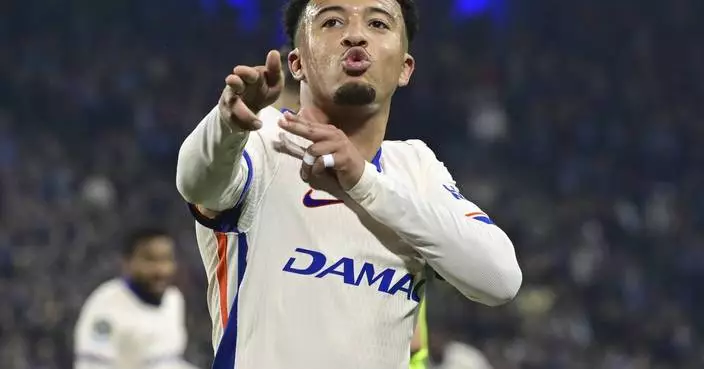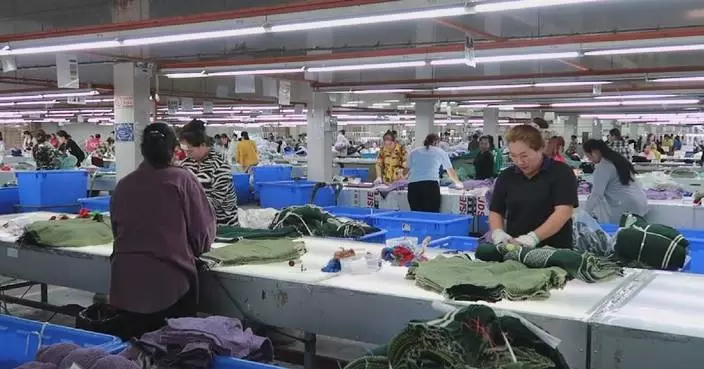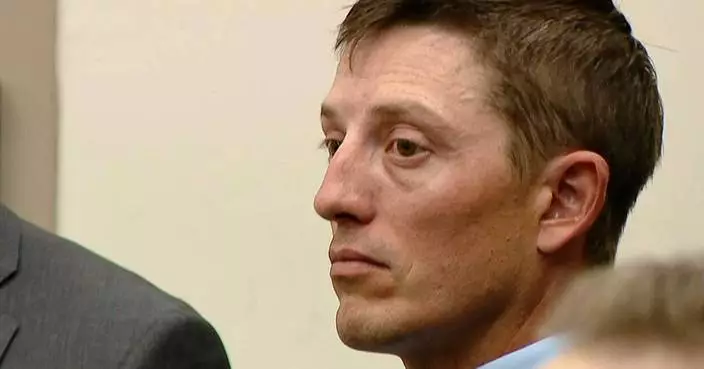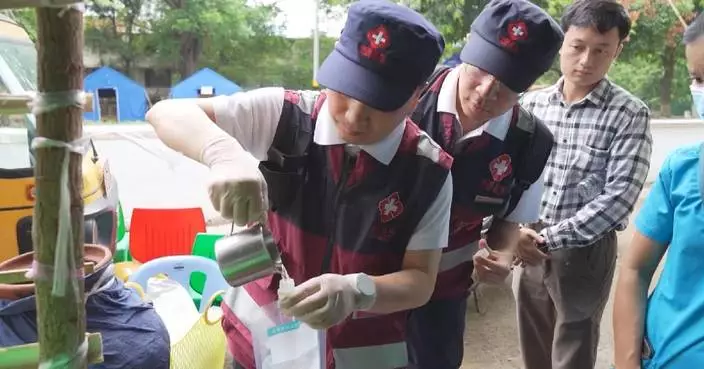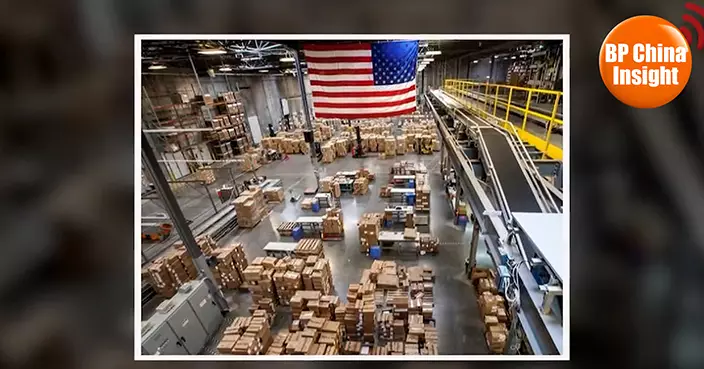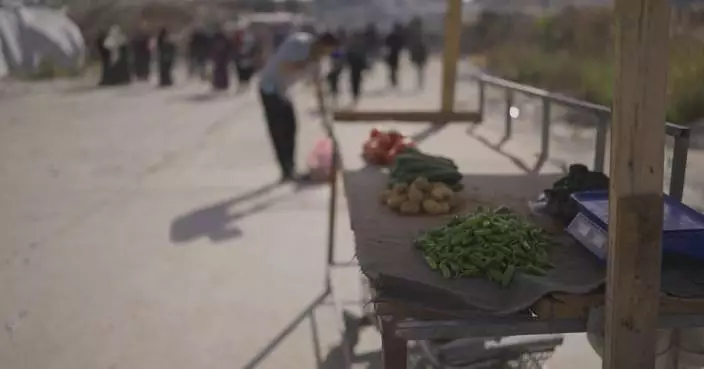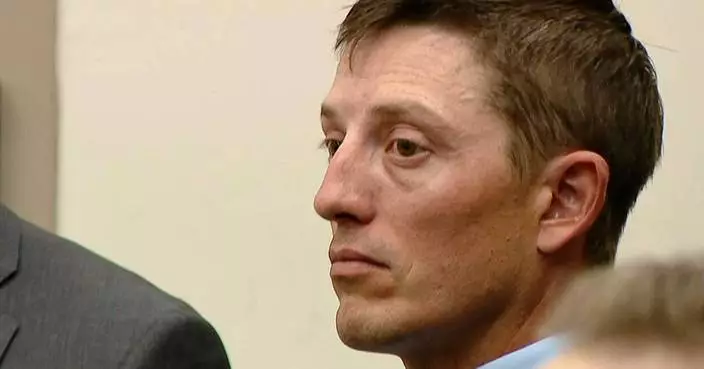SAN SALVADOR, El Salvador (AP) — Salvadoran President Nayib Bukele proposed carrying out a prisoner swap with Venezuela on Sunday, suggesting he would exchange Venezuelan deportees from the United States his government has kept imprisoned for what he called “political prisoners” in Venezuela.
In a post on the social media platform X, directed at President Nicolás Maduro, Bukele listed off a number of family members of high-level opposition figures in Venezuela, journalists and activists detained during the South American government’s electoral crackdown last year.
“The only reason they are imprisoned is for having opposed you and your electoral fraud,” he wrote to Maduro. “However, I want to propose a humanitarian agreement that includes the repatriation of 100% of the 252 Venezuelans who were deported, in exchange for the release and surrender of an identical number (252) of the thousands of political prisoners you hold.”
Among those he listed were the son-in-law of former Venezuelan presidential candidate Edmundo González, a number of political leaders seeking asylum in the Argentine embassy in Venezuela, and what he said were 50 detained citizens from a number of different countries across the world. Bukele also listed the mother of opposition leader María Corina Machado, whose house the political leader has said was surrounded by Venezuelan police in January.
Bukele said he would ask El Salvador’s foreign ministry to be in contact with the Maduro government.
Venezuela’s prosecutor’s office responded Sunday night, calling Bukele’s statements “cynical” and referred to the Salvadoran leader as a “neofascist.”
It demanded Bukele’s government provide the Venezuelan government with a list of the people detained as well as their legal status and medical reports.
“The treatment received by Venezuelans in the United States and El Salvador, constitutes a serious violation of international human rights law and constitutes a crime against humanity,” it said in the statement.
The proposal comes as El Salvador has come under sharp international scrutiny for accepting Venezuelans and Salvadorans deported by the Trump administration, which accused them of being alleged gang members with little evidence. Deportees are locked up in a “mega-prison” know as the Terrorism Confinement Center (CECOT), built by the Bukele government during his crackdown on the country’s gangs.
Controversy has only continued after it was revealed that a Maryland father married to a U.S. citizen, Kilmar Abrego Garcia, was deported by mistake. The U.S. Supreme Court ordered the U.S. government to facilitate his return, but there’s no sign of that happening.
El Salvador’s archbishop José Luis Escobar Alas on Sunday called on Bukele not “to allow our country to become a big international prison.”
Despite the controversy, Bukele maintained that all of the people he has kept in the prison were “part of part of an operation against gangs like the Tren de Aragua in the United States.”
Janetsky reported from Mexico City.
This version has corrected Kilmar Abrego Garcia’s citizenship status.

President Donald Trump greets El Salvador's President Nayib Bukele as he arrives at the West Wing of the White House in Washington, April 13, 2025. (AP Photo/Alex Brandon)
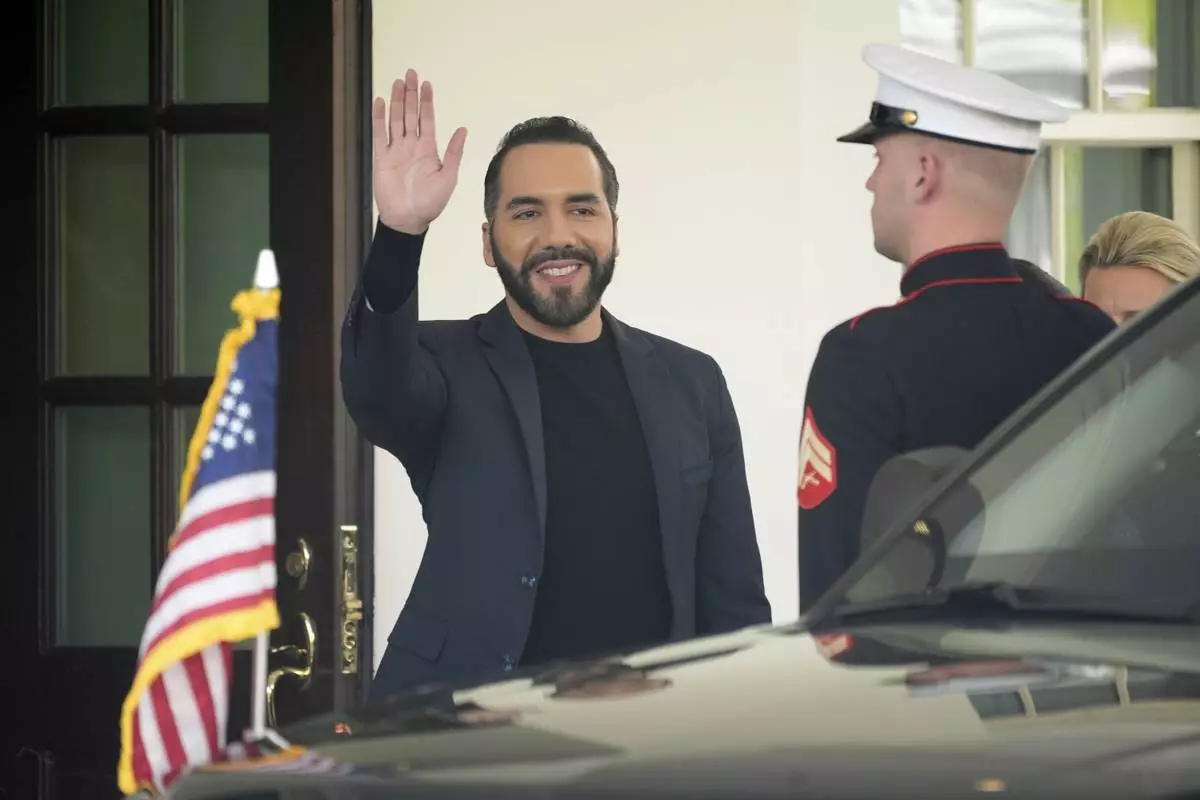
El Salvador's President Nayib Bukele waves as he departs following a meeting at the White House with President Donald Trump, Monday, April 14, 2025, in Washington. (AP Photo/Manuel Balce Ceneta)
TALLINN, Estonia (AP) — The discussions have taken place in an ornate Kremlin hall, on the polished marble of St. Peter’s Basilica and in a famously contentious session in the Oval Office of the White House.
What’s emerged so far from the Washington-led effort to end the war in Ukraine suggests a deal that seems likely to be favorable to Russia: President Donald Trump has sharply rebuked Ukrainian President Volodymyr Zelenskyy, echoed Kremlin talking points, and indicated Kyiv would have to surrender territory and forego NATO membership. What’s more, he has engaged in a rapprochement with Moscow that was unthinkable months ago.
More recently, Trump has offered mixed signals — social media posts that perhaps Russian President Vladimir Putin is stringing him along — and a deal has yet to materialize.
While the optics so far have been in the Kremlin’s favor, no proposals that were put forth have been cemented.
And on Wednesday, Washington and Kyiv signed an agreement granting American access to Ukraine’s vast mineral resources that could enable continued military aid to the country under ongoing attacks from Russia.
Zelenskyy said Thursday the deal was the first result of his “truly historic” meeting with Trump at the Vatican before the funeral of Pope Francis.
One gain for the Kremlin is that Washington is talking again to Moscow after years of extremely strained ties following its 2022 invasion of Ukraine — and not just about the war, said Nikolay Petrov, senior research fellow with the New Eurasian Strategies Centre think tank.
Russian officials and state media from the very start of discussions with Trump’s officials sought to underscore that Ukraine was only one item on the vast agenda of the “two superpowers.” Trump and Putin talked in March about Ukraine but also the Middle East, stopping the proliferation of strategic weapons and even organizing hockey games between the countries.
Russia's main state TV channel reported that the meeting between Putin and Trump envoy Steve-Witkoff showed that Moscow and Washington were building “a new structure of the world” together.
In this sense, “Putin already got a part of what he sought” — the optics of Russia as a country that is on par with the U.S., Petrov said.
Trump has said Crimea, the Ukrainian peninsula Moscow illegally annexed in 2014, “will stay with Russia,” and outlines of a peace proposal his team reportedly presented to Kyiv last month apparently included allowing Russia to keep control of other occupied Ukrainian territories. Trump, who had a contentious meeting with Zelenskyy in the Oval Office on Feb. 28, lashed out at him for publicly rejecting the idea of ceding land, and also said that Kyiv was unlikely to ever join NATO.
All of these reflect Moscow’s long-held positions, and Trump’s echoing of them suggested his administration’s vision was aligned with the Kremlin’s.
Trump also seemingly puts more pressure on Kyiv than Moscow in trying to reach a peace deal and appears eager to return to a more normal relationship with Russia and its “big business opportunities," said Sam Greene of King’s College London.
“Is there any part of this that doesn’t look like a win for Russia? No,” Greene adds.
But so far, all of this has remained nothing but rhetoric, with terms of a possible settlement still very much “in the air,” says Sergey Radchenko, a historian and a professor at the Johns Hopkins School of Advanced International Studies.
Moreover, there are still demands by both Russia and Ukraine that would be hard to reconcile in any kind of peace settlement.
Ukraine refuses to cede any land and wants robust security guarantees against future aggression, possibly involving a contingent of peacekeepers -– something a handful of European nations have been discussing and Russia publicly rejects as a nonstarter.
Russia, in turn, demands that it holds onto the territory it has seized as well as no NATO membership for Ukraine. It also wants Kyiv to “demilitarize,” or significantly reduce its armed force.
Radchenko sees the latter as a major sticking point in peace talks, because a strong, viable army is important for Ukraine to defend itself.
“If there are restrictions on the kinds of weapons Ukraine can receive (from the West) or the size of the army, then it will be very difficult to get them to accept this sort of agreement,” he said.
Russian Foreign Minister Sergey Lavrov seemingly raised the stakes further this week by saying that international recognition of regions annexed from Ukraine by Russia was “imperative” for a peace deal.
Achieving that remains unclear, given that dozens of countries have decried the annexations as violating international law.
Some analysts believe it is in Putin's interest to prolong the war and keep making gains on the battlefield.
Trump, Vice President JD Vance and Secretary of State Marco Rubio have threatened to wash their hands of the peace effort if there is no progress soon.
Putin, in an apparent gesture of willingness to keep talking, announced this week a 72-hour ceasefire starting May 8 for Russia's Victory Day holiday that marks the defeat of Nazi Germany in World War II.
Zelenskyy dismissed the gesture as a further attempt by Putin at “manipulation” to string along the U.S., saying a ceasefire should begin immediately and last longer.
Greene noted that the Russian ruble and markets have been doing better recently over expectations of a peace deal and U.S. businesses and investors coming back, "and there may be a price to be paid” for pulling out the rug from under that.
The larger question is what happens on the battlefield if the Trump administration withdraws from the peace effort.
“When the Trump administration says they’ll walk away, we don’t know what that means. Does that mean they walk away from negotiations and keep supporting Ukraine?” Greene said.
Greene says that Ukraine probably doesn’t feel confident that the U.S. stepping back from the process means that Washington will keep supporting Kyiv, adding that Russia may not be sure of the Trump administration ending aid, either.
“I think it’s very difficult for the Kremlin to calculate the risks of dragging this out,” he said.
And U.S. Treasury Secretary Sctott Bessent said the mineral deal "signals clearly to Russia that the Trump administration is committed to a peace process centered on a free, sovereign, and prosperous Ukraine over the long term.”
A lot depends on whether Europe can step up and fill any gaps in U.S. aid.
If Trump walks away from the peace effort and still pursues normalizing relations with Russia, lifting sanctions, “this will amount to a major breakthrough” for Putin, but it's not a given, Radchenko says.
That would be an uphill battle for Trump as “there’s a lot of congressional sanctions that are predicated on the war in Ukraine,” Greene notes.
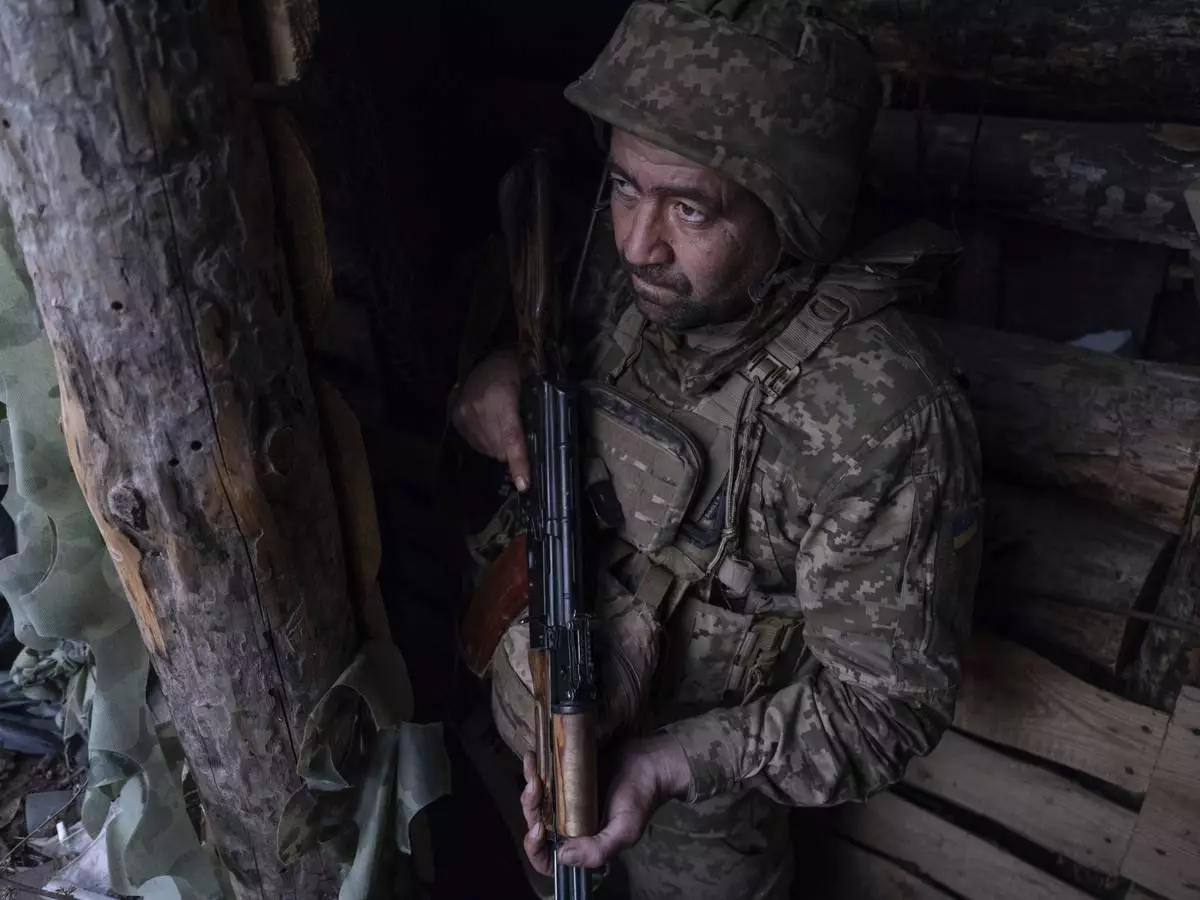
FILE - In this photo provided by Ukraine's 93rd Kholodnyi Yar Separate Mechanized Brigade press service, a soldier looks out of a shelter on the anti-drone firing position in Kostyantynivka, the site of the heavy battles with the Russian troops in the Donetsk region, Ukraine, April 24, 2025. (Iryna Rybakova/Ukraine's 93rd Mechanized Brigade via AP, File)
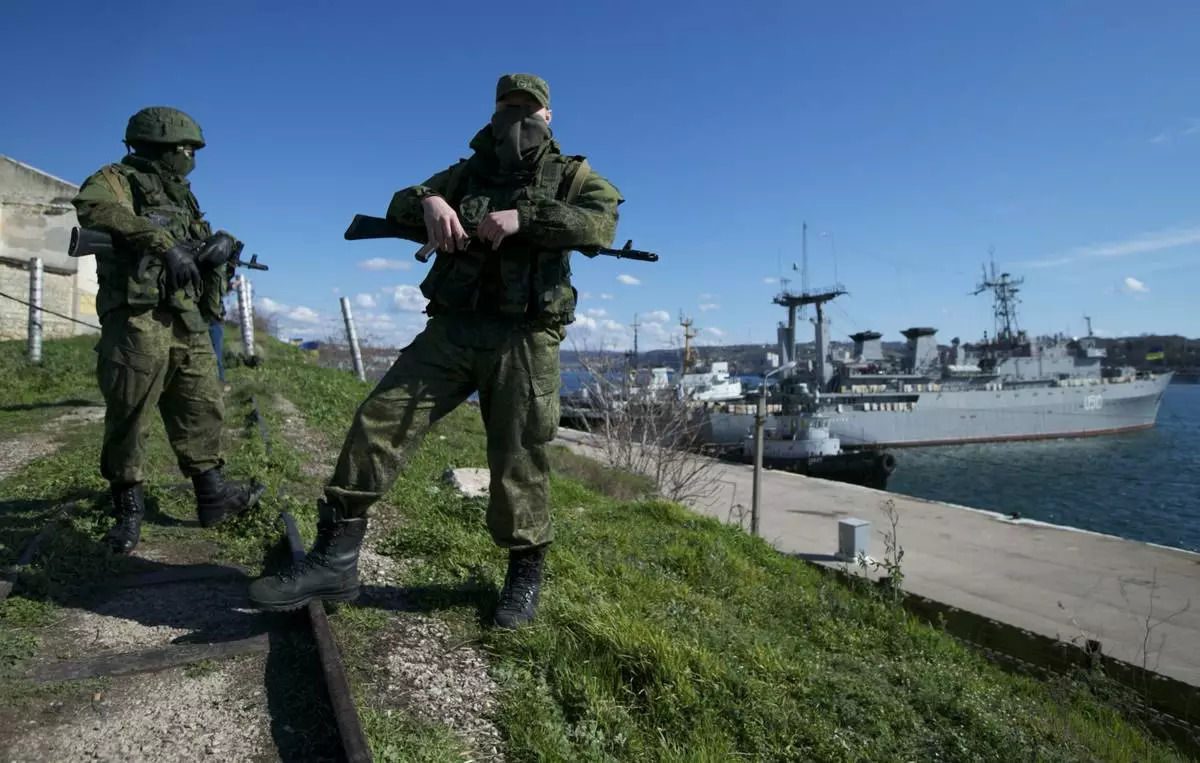
FILE - Russian soldiers guard a pier where two Ukrainian naval vessels are moored, in Sevastopol, on the Crimean Peninsula, March 5, 2014. (AP Photo, File)
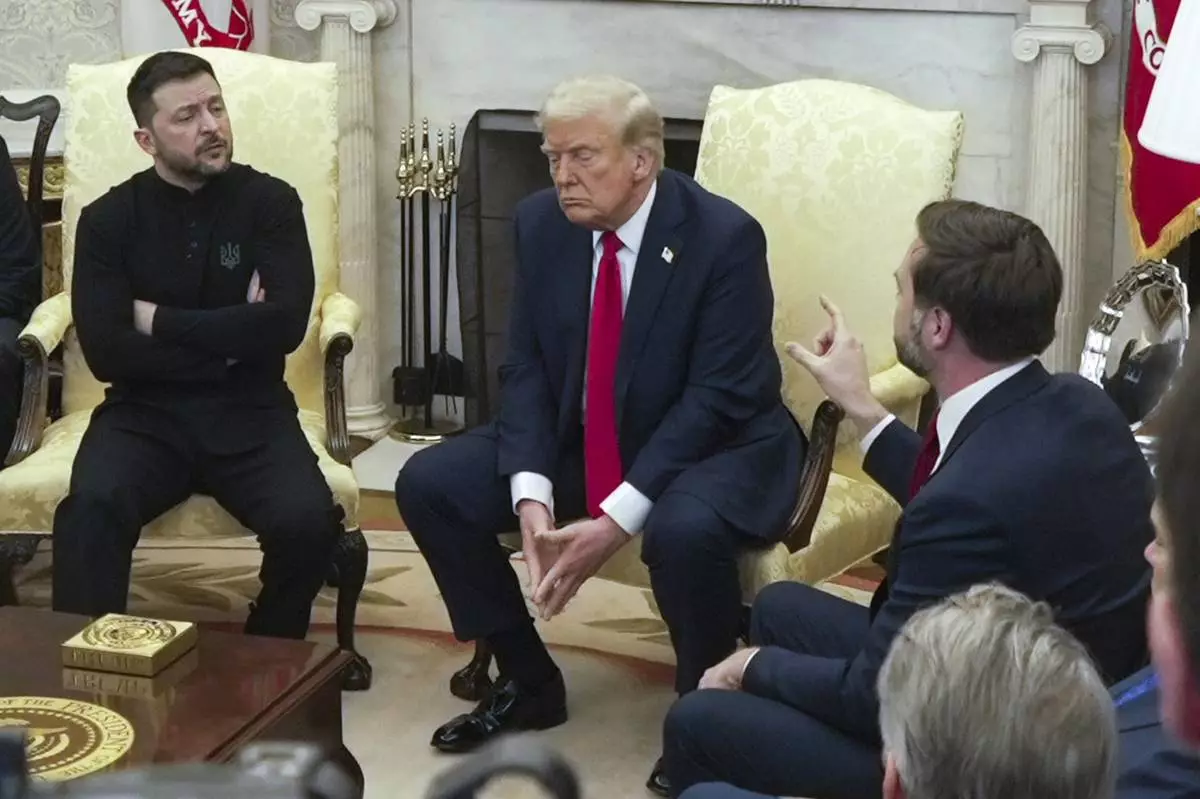
FILE - Vice President JD Vance, right, speaks with Ukrainian President Volodymyr Zelenskyy, left, as President Donald Trump listens, in the Oval Office at the White House, Feb. 28, 2025, in Washington. (AP Photo/ Mystyslav Chernov, File)
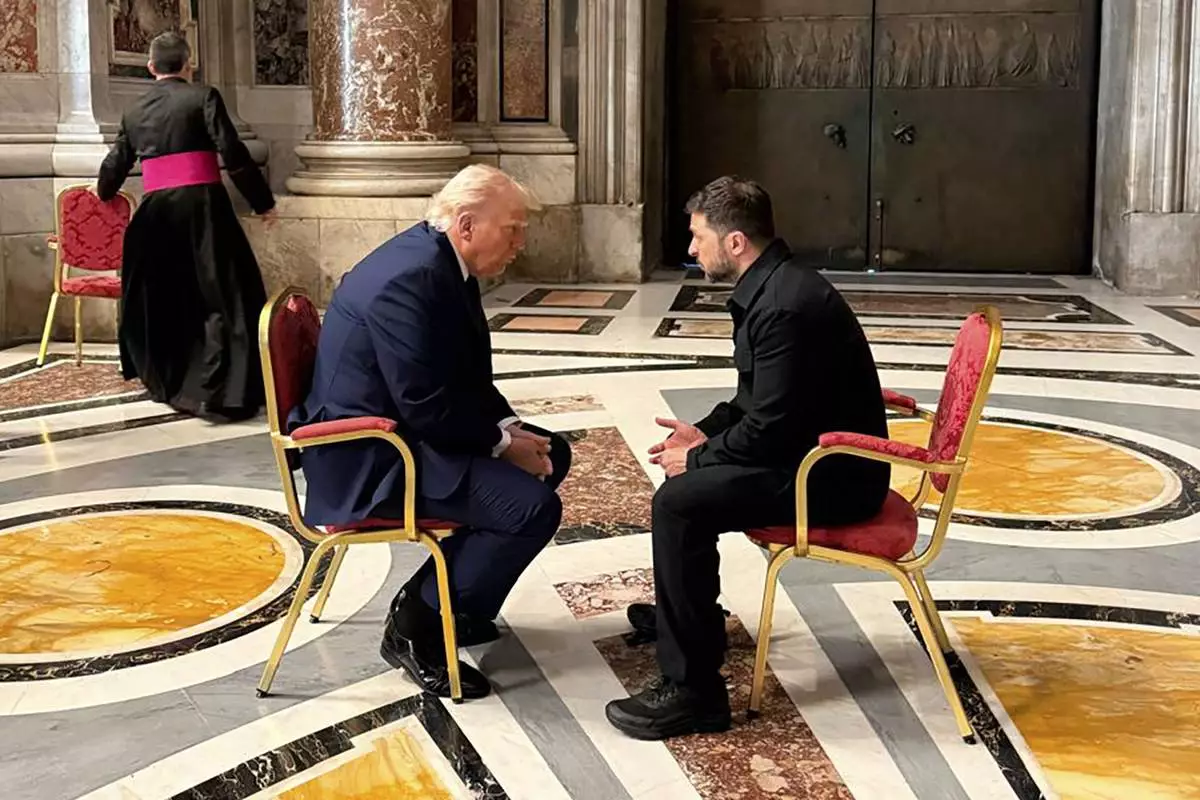
FILE - In this photo provided by the Ukrainian Presidential Press Office, President Volodymyr Zelenskyy, right, and President Donald Trump, talk as they attend the funeral of Pope Francis in St. Peter’s Basilica in Vatican City, April 26, 2025.(Ukrainian Presidential Press Office via AP, File)
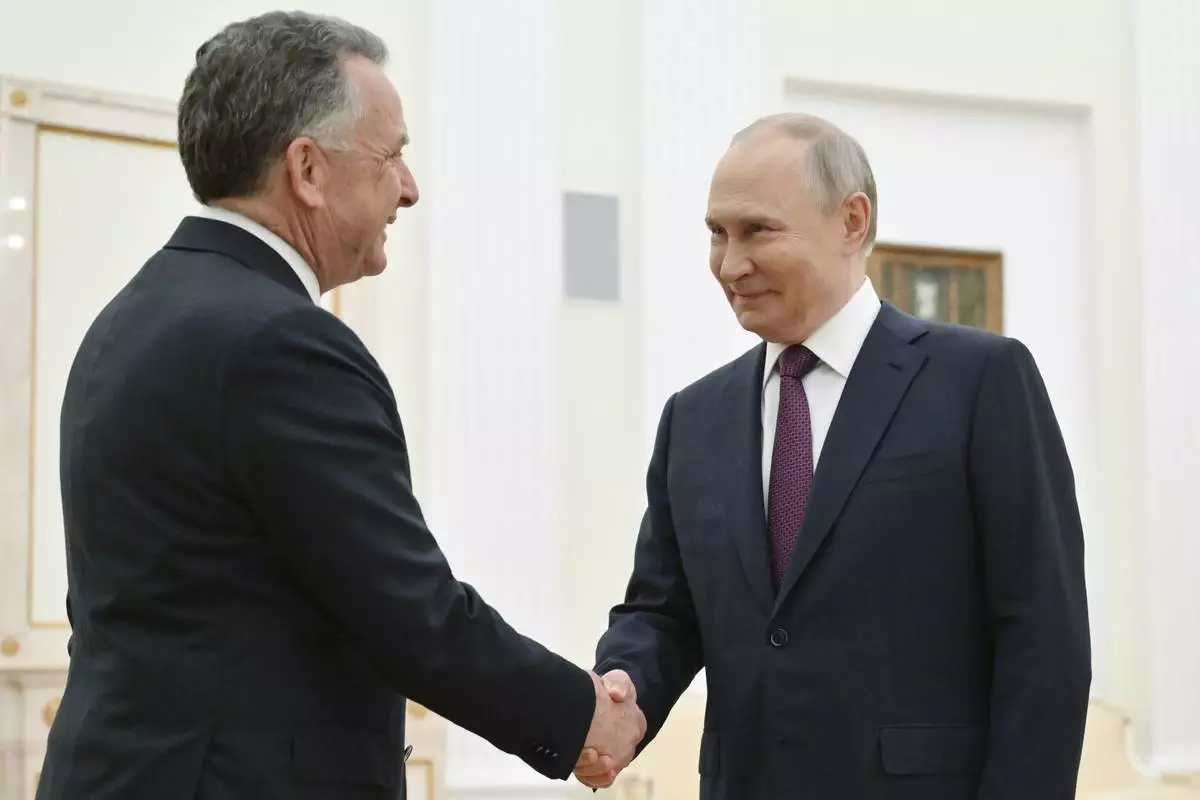
FILE - Russian President Vladimir Putin, right, and U.S. special envoy Steve Witkoff greet each other prior to their talks at the Kremlin in Moscow, Russia, April 25, 2025. (Kristina Kormilitsyna, Sputnik, Kremlin Pool Photo via AP, File)
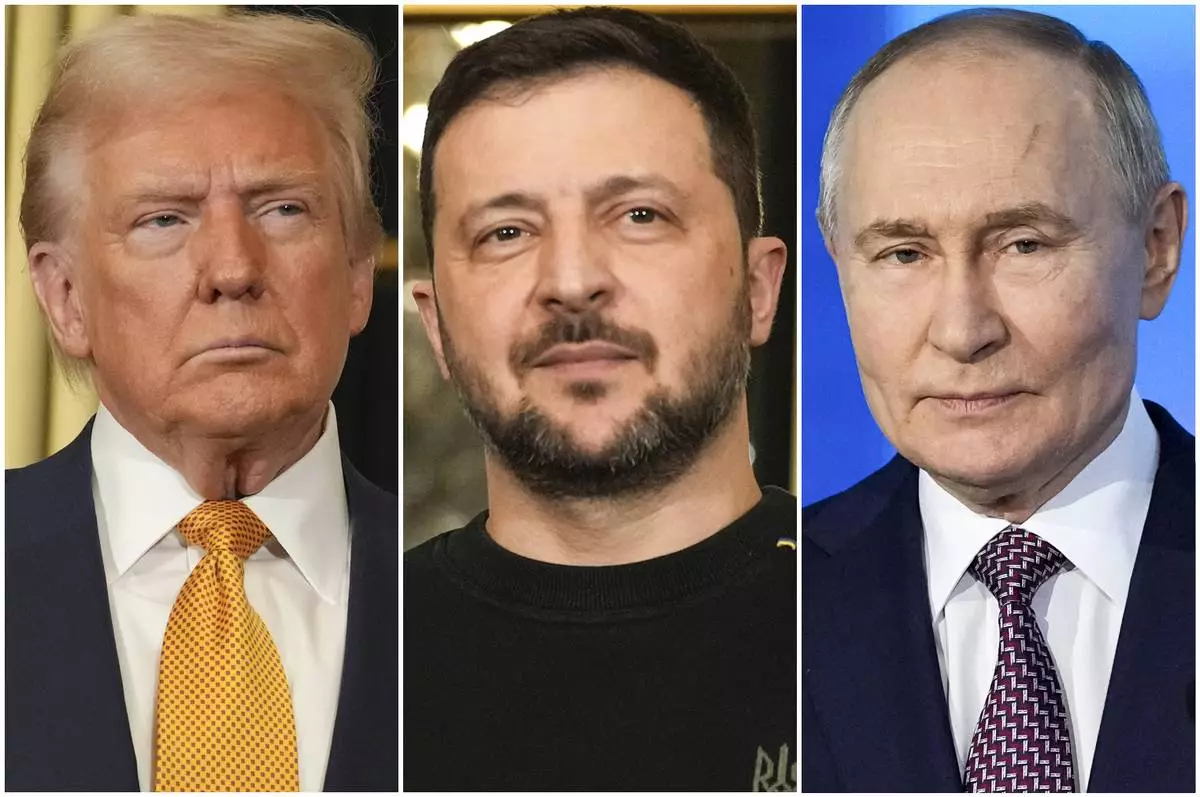
FILE - In this combination of file photos, President Donald Trump, left, and Ukraine's President Volodymyr Zelenskyy, center, are seen at the Elysee Palace, Dec. 7, 2024 in Paris, and President Vladimir Putin, right, addresses a Technology Forum in Moscow, Feb. 21, 2025. (AP Photo/Aurelien Morissard, left and center, Pavel Bednyakov, right, File)












